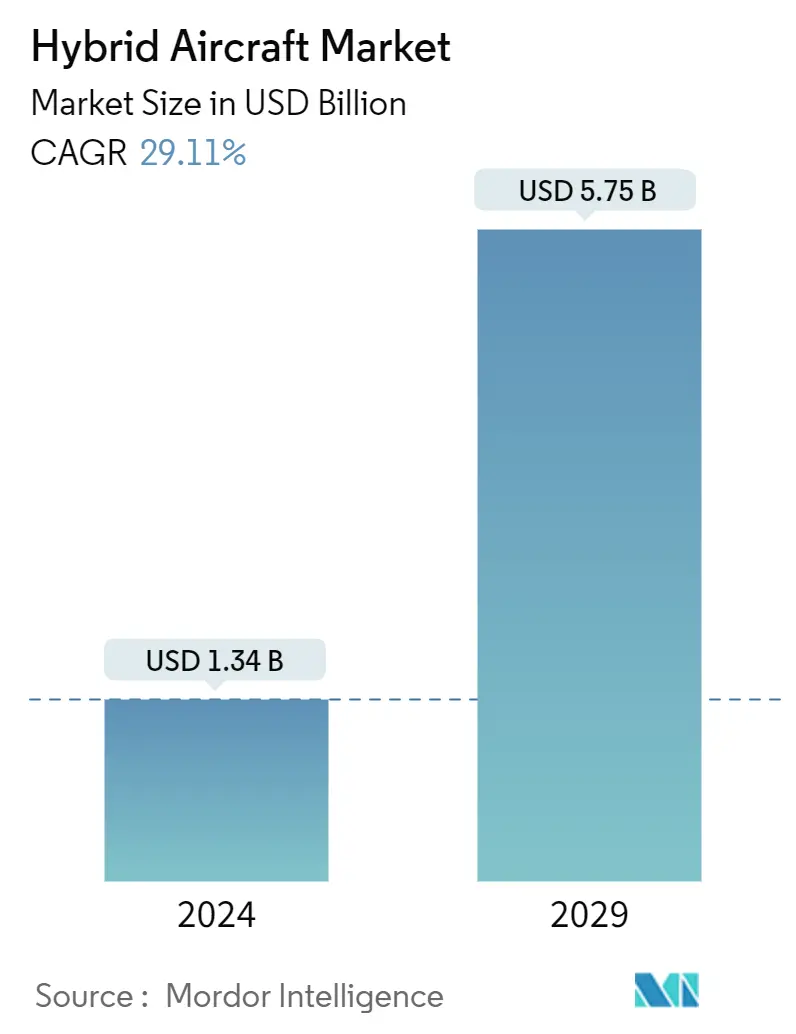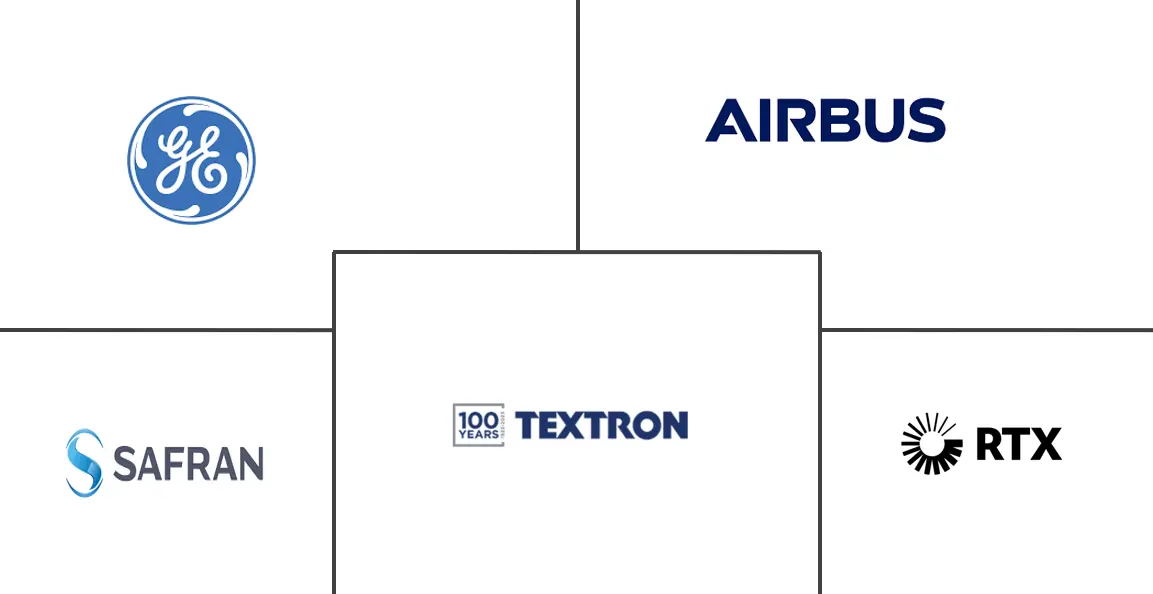Market Size of Hybrid Aircraft Industry

| Study Period | 2019-2029 |
| Market Size (2024) | USD 1.34 Billion |
| Market Size (2029) | USD 5.75 Billion |
| CAGR (2024 - 2029) | 29.11 % |
| Fastest Growing Market | Europe |
| Largest Market | North America |
| Market Concentration | Low |
Major Players
*Disclaimer: Major Players sorted in no particular order |
Hybrid Aircraft Market Analysis
The Hybrid Aircraft Market size is estimated at USD 1.34 billion in 2024, and is expected to reach USD 5.75 billion by 2029, growing at a CAGR of 29.11% during the forecast period (2024-2029).
- A confluence of variables impacting the aviation sector is driving significant global growth in the hybrid aircraft market. With increasing awareness of the impact on the environment, there is a spike in demand for hybrid aircraft that offer lower emissions and operating efficiency. This corresponds with worldwide aspirations to adopt eco-friendly aviation solutions, establishing hybrid aircraft as critical in determining the future of sustainable air transportation. The hybrid aircraft market is growing due to factors such as greater fuel economy compared to traditional aircraft, developments in electric propulsion technology, and increased expenditures by industry players.
- However, high development costs and a lack of airport infrastructure impede market expansion. Collaboration between industry players and regulatory agencies is thought necessary to establish a favorable environment for hybrid aircraft market demand. Furthermore, new use cases in urban air transportation, as well as an increase in the deployment of hybrid aircraft for defense purposes, provide significant potential prospects for industry participants.
Hybrid Aircraft Industry Segmentation
A hybrid electric aircraft is an aircraft with a hybrid electric powertrain. As the energy density of lithium-ion batteries is much lower than aviation fuel, a hybrid electric powertrain may effectively increase flight range compared to pure electric aircraft.
The hybrid aircraft market is segmented based on aircraft type, mode of operation, lift technology, and geography. Based on aircraft type, the market is divided into regional transport aircraft, business jets and light aircraft, and advanced air mobility (AAM). Based on the mode of operation, the market is classified into piloted and autonomous. Based on lift technology, the market is categorized into conventional takeoff and landing (CTOL), short takeoff and landing (STOL), and vertical takeoff and landing (VTOL). The report also covers the market sizes and forecasts for the hybrid aircraft market in major countries across different regions.
For each segment, the market size is provided in terms of value (USD).
| Aircraft Type | |
| Regional Transport Aircraft | |
| Business Jets and Light Aircraft | |
| Advanced Air Mobility |
| Mode of Opertaion | |
| Piloted | |
| Autonomous |
| Lift Technology | |
| Conventional Take-off and Landing | |
| Short Take-off and Landing | |
| Vertical Take-off and Landing |
| Geography | |||||||
| |||||||
| |||||||
| |||||||
| |||||||
|
Hybrid Aircraft Market Size Summary
The hybrid aircraft market is experiencing robust growth, driven by increasing environmental awareness and the demand for sustainable aviation solutions. This market is characterized by the integration of advanced propulsion systems that offer improved fuel efficiency and reduced emissions compared to traditional aircraft. The development of electric propulsion technology and high-capacity batteries has been pivotal in enhancing the performance of hybrid aircraft, particularly for short-haul and regional flights. Despite the promising advancements, the market faces challenges such as high development costs and insufficient airport infrastructure. Collaborative efforts between industry players and regulatory bodies are essential to create a conducive environment for market expansion. Additionally, new applications in urban air transportation and defense sectors present significant opportunities for market participants.
In Europe, the hybrid aircraft market is poised for growth due to technological advancements and strategic investments. The region's focus on new transportation modes, supported by collaborations among major aerospace companies and EU funding, aims to lead in next-generation green aircraft. Countries like the UK, France, and Germany contribute unique technological competencies that enhance cross-border initiatives. The market is fragmented, with key players like RTX Corporation, Textron Inc., General Electric Company, Airbus SE, and Safran SA actively engaging in product innovation and strategic partnerships to maintain their competitive edge. The introduction of hybrid-electric aircraft models, such as Airbus's Eco Pulse and Embraer's Energia Hybrid E19-HE, underscores the industry's commitment to achieving significant reductions in CO2 emissions and advancing towards sustainable aviation.
Hybrid Aircraft Market Size - Table of Contents
-
1. MARKET DYNAMICS
-
1.1 Market Overview
-
1.2 Market Drivers
-
1.3 Market Restraints
-
1.4 Porter's Five Forces Analysis
-
1.4.1 Bargaining Power of Buyers/Consumers
-
1.4.2 Bargaining Power of Suppliers
-
1.4.3 Threat of New Entrants
-
1.4.4 Threat of Substitute Products
-
1.4.5 Intensity of Competitive Rivalry
-
-
-
2. MARKET SEGMENTATION
-
2.1 Aircraft Type
-
2.1.1 Regional Transport Aircraft
-
2.1.2 Business Jets and Light Aircraft
-
2.1.3 Advanced Air Mobility
-
-
2.2 Mode of Opertaion
-
2.2.1 Piloted
-
2.2.2 Autonomous
-
-
2.3 Lift Technology
-
2.3.1 Conventional Take-off and Landing
-
2.3.2 Short Take-off and Landing
-
2.3.3 Vertical Take-off and Landing
-
-
2.4 Geography
-
2.4.1 North America
-
2.4.1.1 United States
-
2.4.1.2 Canada
-
-
2.4.2 Europe
-
2.4.2.1 United Kingdom
-
2.4.2.2 France
-
2.4.2.3 Germany
-
2.4.2.4 Italy
-
2.4.2.5 Rest of Europe
-
-
2.4.3 Asia-Pacific
-
2.4.3.1 China
-
2.4.3.2 India
-
2.4.3.3 Japan
-
2.4.3.4 South Korea
-
2.4.3.5 Rest of Asia-Pacific
-
-
2.4.4 Latin America
-
2.4.4.1 Brazil
-
2.4.4.2 Rest of Latin America
-
-
2.4.5 Middle East and Africa
-
2.4.5.1 Saudi Arabia
-
2.4.5.2 South Africa
-
2.4.5.3 Rest of Middle East and Africa
-
-
-
Hybrid Aircraft Market Size FAQs
How big is the Hybrid Aircraft Market?
The Hybrid Aircraft Market size is expected to reach USD 1.34 billion in 2024 and grow at a CAGR of 29.11% to reach USD 5.75 billion by 2029.
What is the current Hybrid Aircraft Market size?
In 2024, the Hybrid Aircraft Market size is expected to reach USD 1.34 billion.

